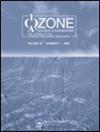Efficient Dye Removal Using Fe3O4.MnO2.MoS2 Nanocomposite in Optimized Photocatalytic Ozonation Process
IF 1.4
4区 环境科学与生态学
Q3 ENGINEERING, ENVIRONMENTAL
引用次数: 3
Abstract
ABSTRACT In this study, Fe3O4.MnO2.MoS2 nanocatalyst has been fabricated for the first time and applied in the photocatalytic ozonation (PCO) process. The efficiency of this ternary heterostructure nanocomposite was evaluated in the removal of Acid Blue 113 (AB113) dye with 100 mg.L−1 concentration utilizing response surface methodology (RSM). The optimal condition of the process was attained at pH = 3, using 2 mg of the nanocatalyst and 300 mg.L−1 ozone dosage applied over 20 min. High efficiency of AB113 removal (99%) was observed at the optimal condition. In addition, the performance of the synthesized catalyst in the PCO process was investigated in the treatment of a real textile effluent sample. The PCO has been found to be more efficient than the individual photocatalysis and catalytic ozonation methods due to the synergistic effect between the two oxidation systems. The results proved that Fe3O4.MnO2.MoS2 can be used as a highly efficient catalyst in the PCO process.利用Fe3O4.MnO2高效去除染料二氧化硅纳米复合材料光催化臭氧氧化优化研究
在本研究中,Fe3O4.MnO2。首次制备了二硫化钼纳米催化剂,并将其应用于光催化臭氧氧化(PCO)工艺。考察了该三元异质结构纳米复合材料对100 mg酸性蓝113 (AB113)染料的去除效果。利用响应面法(RSM)测定L−1浓度。最佳工艺条件为pH = 3,纳米催化剂用量为2 mg,纳米催化剂用量为300 mg。在最佳条件下,L−1臭氧投加量超过20 min, AB113的去除率高达99%。此外,通过对实际纺织废水样品的处理,考察了合成催化剂在PCO工艺中的性能。由于两种氧化系统之间的协同作用,PCO已被发现比单独的光催化和催化臭氧化方法更有效。结果表明:Fe3O4.MnO2。二硫化钼可作为PCO工艺的高效催化剂。
本文章由计算机程序翻译,如有差异,请以英文原文为准。
求助全文
约1分钟内获得全文
求助全文
来源期刊

Ozone: Science & Engineering
环境科学-工程:环境
CiteScore
5.90
自引率
11.10%
发文量
40
审稿时长
2 months
期刊介绍:
The only journal in the world that focuses on the technologies of ozone and related oxidation technologies, Ozone: Science and Engineering brings you quality original research, review papers, research notes, and case histories in each issue. Get the most up-to date results of basic, applied, and engineered research including:
-Ozone generation and contacting-
Treatment of drinking water-
Analysis of ozone in gases and liquids-
Treatment of wastewater and hazardous waste-
Advanced oxidation processes-
Treatment of emerging contaminants-
Agri-Food applications-
Process control of ozone systems-
New applications for ozone (e.g. laundry applications, semiconductor applications)-
Chemical synthesis.
All submitted manuscripts are subject to initial appraisal by the Editor, and, if found suitable for further consideration, to peer review by independent, anonymous expert referees.
 求助内容:
求助内容: 应助结果提醒方式:
应助结果提醒方式:


